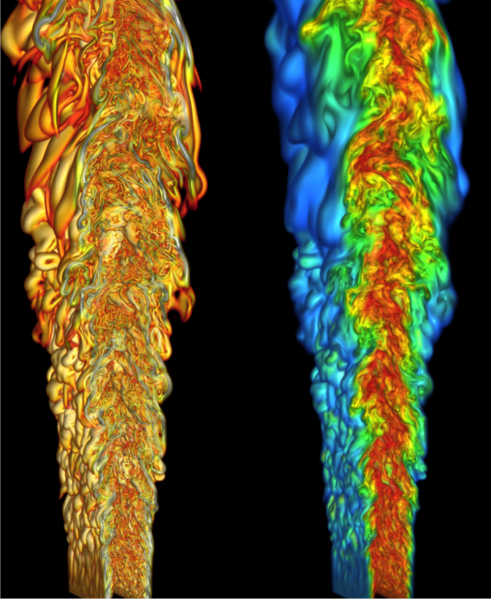File:Combustion research (8134288333).png

Original file (830 × 1,013 pixels, file size: 1,022 KB, MIME type: image/png)
Captions
Captions
Summary[edit]
| DescriptionCombustion research (8134288333).png |
This line of research is critical to the American energy economy, given that three-quarters of the fossil fuel used in the United States goes to powering cars and trucks, which produce one-quarter of the country’s greenhouse gases. Titan will allow researchers to model large-molecule hydrocarbon fuels such as the gasoline surrogate isooctane; commercially important oxygenated alcohols such as ethanol and butanol; and biofuel surrogates that blend methyl butanoate, methyl decanoate and n-heptane. “In particular, these simulations will enable us to understand the complexities associated with strong coupling between fuel chemistry and turbulence at low preignition temperatures,” noted team member Jacqueline Chen of Sandia National Laboratories. “These complexities pose challenges, but also opportunities, as the strong sensitivities to both the fuel chemistry and to the fluid flows provide multiple control options which may lead to the design of a high-efficiency, low-emission, optimally combined engine-fuel system.” The Oak Ridge Leadership Computing Facility (OLCF) is home to Titan, the world’s most powerful supercomputer for open science with a theoretical peak performance exceeding 20 petaflops (quadrillion calculations per second). That kind of computational capability—almost unimaginable—is on par with each of the world’s 7 billion people being able to carry out 3 million calculations per second. Image courtesy Oak Ridge National Laboratory CAPTION/CREDIT: A direct numerical simulation with the S3D code used to model turbulent combustion shows jet-flame stabilization of a simple fuel, ethylene, as it mixes with heated, co-flowing air. An indicator of mixing rate, left, shows white for highest and orange for lowest values. The degree of mixedness is shown in red-to-blue spectrum at right, where ethylene is red and co-flowing, heated air is blue. The simulation was performed by Chun Sang Yoo, Edward S. Richardson, Ramanan Sankaran and Jacqueline H. Chen. Data visualization by Hongfeng Yu. |
| Date | |
| Source | Combustion research |
| Author | Oak Ridge National Laboratory |
Licensing[edit]
- You are free:
- to share – to copy, distribute and transmit the work
- to remix – to adapt the work
- Under the following conditions:
- attribution – You must give appropriate credit, provide a link to the license, and indicate if changes were made. You may do so in any reasonable manner, but not in any way that suggests the licensor endorses you or your use.
| This image was originally posted to Flickr by oakridgelabnews at https://flickr.com/photos/37940997@N05/8134288333. It was reviewed on 26 May 2020 by FlickreviewR 2 and was confirmed to be licensed under the terms of the cc-by-2.0. |
26 May 2020
File history
Click on a date/time to view the file as it appeared at that time.
| Date/Time | Thumbnail | Dimensions | User | Comment | |
|---|---|---|---|---|---|
| current | 23:14, 26 May 2020 |  | 830 × 1,013 (1,022 KB) | Tm (talk | contribs) | Transferred from Flickr via #flickr2commons |
You cannot overwrite this file.
File usage on Commons
The following 2 pages use this file:
Metadata
This file contains additional information such as Exif metadata which may have been added by the digital camera, scanner, or software program used to create or digitize it. If the file has been modified from its original state, some details such as the timestamp may not fully reflect those of the original file. The timestamp is only as accurate as the clock in the camera, and it may be completely wrong.
| Horizontal resolution | 59.06 dpc |
|---|---|
| Vertical resolution | 59.06 dpc |